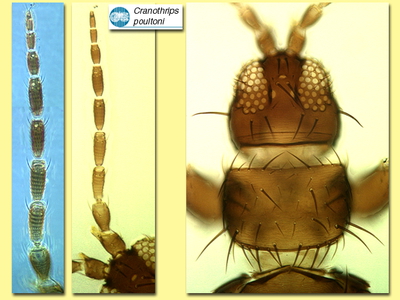Figures
Fig. 1 Antenna, head and pronotum
Fig. 2 Head, pro-, meso- and metanotum
Fig. 3 Fore and hind wing
Fig. 4 Sternite VII
Fig. 5 Head (dorsal), III. and IV. antennal segment
Species
Cranothrips poultoni Bagnall
Biology
Breeding within the white flowers of certain Grevillea species.
Distribution
Western Australia.
Recognition
Body and legs brown, antennal segment III light brown; forewings brown with a pale band medially and at base. Head with 4 pairs of very long setae, ocellar setae pair III arising close together within ocellar triangle but longer than width of a compound eye; 3 pairs of equally long postocular setae. Antennae 9-segmented, each segment fully distinct and with many rings of microtrichia; sense area on III & IV narrow and transverse at apex of segment. Pronotum with at least 10 pairs of long setae. Metanotum with concentric circles of microtrichia on anterior third; median setae small and arising near posterior margin. Forewing first and second veins with complete rows of long setae. Fore tarsi without a recurved claw at apex. Tergite IX with pair of trichobothria near posterior margin. Median sternites with numerous discal setae close to posterior margin; sternite VII with paired lobes on posterior margin. Male similar to female but smaller; tergite I elongate and with two longitudinal ridges.
Related species
Cranothrips includes one species from South African together with several from Australia. In contrast, its European equivalent Melanthrips contains many more species. These two genera, together with a few other small genera, are sometimes placed in the family Melanthripidae, a separate family from the Aeolothripidae, because of the structure of the antennae and sternite VII. None of the included species is known to be a pest, and many are presumed to be host specific in their biology.






